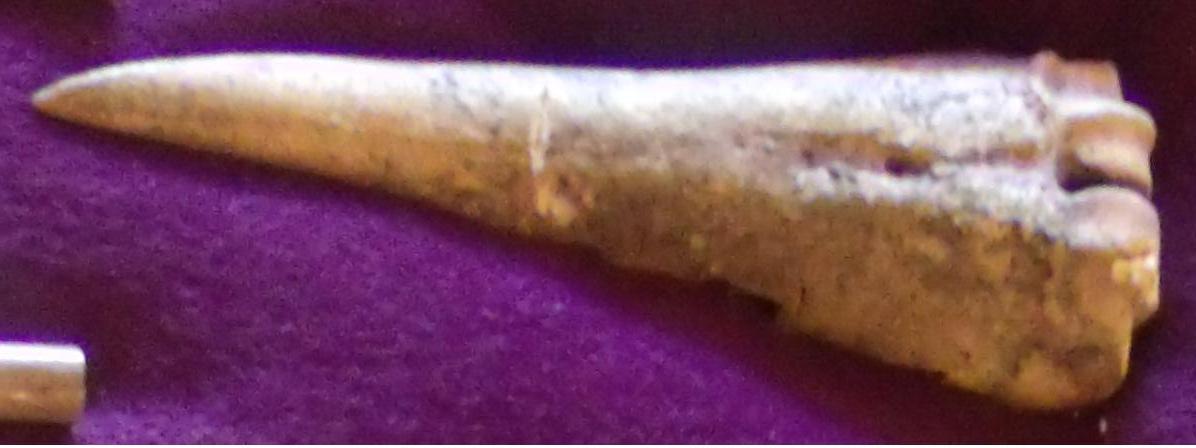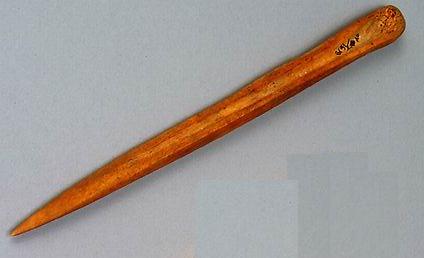
William Webb identified 4 examples of the Cannon Bone Awl from the village site at the Henry Island site. This type awl is made from the cannon or lower leg bone of the deer, one of the strongest bones in the deer skeleton. Awls of this type might be confused with the bone daggers described by Gordon Willey (1949) from several Florida sites. The awl form would be shorter and would show considerable polish on the distal end from friction against materials as well as polish on the upper portion from handling. Breakage might also be common.
The examples illustrated here are from Bob’s Mound along the Ogeechee River in Jenkins County, Georgia. The example to the right is a pottery decorating tool for Stallings punctate pottery. Many of these have been recovered in Stallings sites. The Bob’s Mound site dated to the Late Archaic period between 2,000 and 2,400 B.C. William Webb (1951) recovered 4 examples from the predominately Middle Woodland Henry Island site, one example of this type at the Harris site (Ms 80) in Marshall County, Alabama and from the Cox site (Ja176). The example from the Harris site came from general excavation and the site contained 60% Mulberry Creek Plain pottery that dated between A.D. 80 and 1000. The example from the Cox site in Jackson County, Alabama came from Zone C that contained both Woodland and Mississippian period pottery.
Webb’s work at the Henry Island site also produced one interesting variant of the Cannon Bone awl or perhaps a skewer similar to one illustrated by James B. Griffin.

Cylindrical awls appear to have been made from several different small bones from deer as well as other animals. They are round in cross section and are usually 3 inches or so in length. There is a joint configuration at the top of the awl and the distal end is worked to a fine point, apparently for perforating soft materials.
William Webb (1951) used this name to describe 22 very thin cylindrical awls that he recovered from the Roden site (Ms53A) in Marshall County, Alabama. Again, Webb did not illustrate these awls, but he did describe them as cylindrical. One can only assume that these were probably about 3 inches in length and would appear as a needle without the eye at the top. Like other small, thin awls, they were probably used to perforate soft material like hides or fabrics. Fish spines have been recovered in sites that might have served the same purpose, but only the presence of use ware at the top joint area and dulled or polished points would separate them from other waste faunal or marine remains. Bones used for this purpose would be recovered from general excavation as in Webb’s case rather than in a midden context.
Webb’s recovery at the Roden site where sherds of Mulberry Creek and Long Branch Fabric sherds were recovered would date between A.D. 80 and 1000. Thomas M.N. Lewis and Madeline Kneberg (1946) illustrated a number of awls that they termed “bone needles” from the Dallas component of the Hiwassee Island site, but none of the examples had eye holes in them and thus might have been termed “needle awls” by Webb.

The “Trigger Awl”, named for its general gun-like shape, is made from a deer ulna bone (the upper portion of the foreleg of the deer). The upper portion of the bone is often polished from handling and the lower portion of the bone is often broken from heavy use. Trawick Ward 1993) noted that 36 of the 109 bone tools recovered from the Lower Saratown site in North Carolina were awls, making them the most frequently recovered bone tool category found. Many were portions of trigger awls.
The Lower Saratown site dates to the Sara Indians that occupied the site between A.D. 1620 and 1670. Webb recovered examples of this awl at MS32 and in the midden at MS43 in Marshall County, Alabama. These were Historic and Middle Woodland period sites respectively. The distal end of this awl was honed to a sharp point and the handle portion was polished through use. Of the 75 bone tools recovered in the Central Georgia Survey, only one ulna awl was recovered and it was from a Late Archaic midden within the Ogeechee River basin. DeJarnette, Kurjack, and Cambron (1962) included the ulna awl in the Morrow Mountain tool complex at the Stanfield-Worley Bluff Shelter site in Alabama, dating this tool form to as early as the Middle Archaic period and 7,500 years B.P.
Splinter awls are found at most archaeological sites where bone can be preserved at all and were in use throughout all prehistoric periods. Splinter awls are made from bone splinters that were sharpened at one end but remain otherwise without modification. Awls can vary from 3 to 6 inches in length. Polish from wear may appear at the point from contact with material and along the shaft from handling. They were generally used to perforate softer materials, but may have also been used in making baskets or other types of weaving.
Splinter awls require little more than the sharpening of one end to be ready for use and are one of the more numerous artifacts recovered from archaeological sites. Web (1951) recovered 62 of these awls from the Henry Island site (Ms55) in Marshall County, Alabama. The site dated to the Woodland and Mississippian periods.
In his survey of the Guntersville Basin, William Webb (1951) recovered one of these awls from site Ms32, located on McKee Island on the Tennessee River in Marshall County, Alabama.
As illustrated in the drawing, the metatarsal bones are those that form the upper part of the turkey’s foot. Like all bird bones, this bone is hollow and is about 2.5 inches or so in length. Ward also reported the recovery of one of these awls from the Holt site in North Carolina. The site contained Haw River pottery and a variety of Archaic point types with no indication of the age of the awl. Preservation of such a delicate bone would be dependent on an environment high in calcium like a shell midden.
This example was recovered from the Ogeechee River basin in a Late Archaic context. Webb’s MS32 site contained over 5,000 sherds of Plain Shell tempered pottery and a large number of European trade goods.
Webb, William S. and Charles G. Wilder
1951 An Archaeological Survey Of Guntersville Basin, University of Kentucky Press indication of the age of the awl. Preservation of such a delicate bone would be dependent on an environment high in calcium like a shell midden.
Webb, William S. and Charles G. Wilder
1951 An Archaeological Survey Of Guntersville Basin, University of Kentucky Press
Stoltman, James B.
1974 Groton Plantation, An Archaeological Study of a South Carolina Locality, Harvard University
Webb, William S. and Charles G. Wilder
1951 An Archaeological Survey Of Guntersville Basin, University of Kentucky Press